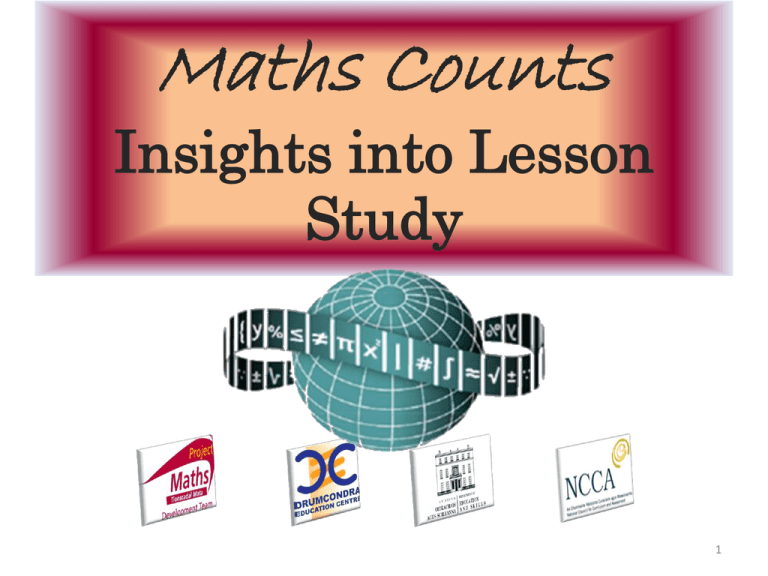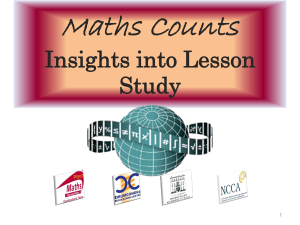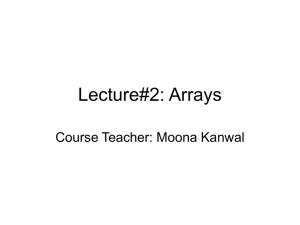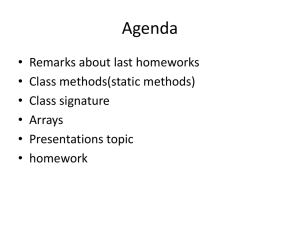Using the array model with first-year students
advertisement

Maths Counts Insights into Lesson Study 1 • Team members: Annabel Devereux and Sarah Gallagher • Class: First year • Title: “Use of the array model in first year” 2 • Introduction: Focus of Lesson • Student Learning : What we learned about students’ understanding based on data collected • Teaching Strategies: What we noticed about our own teaching • Strengths & Weaknesses of adopting the Lesson Study process 3 Topic investigated: “Use of the array model to make sense of the distributive law in first year” • How we planned the lesson • Resources used: • • • • • Board work Student “show me” boards Resources from Project Maths workshops on the array model Calculators for checking answers A PowerPoint to show images of the array model 4 Prior Knowledge • Place Value • What is multiplication? • Factors • Product • Variables • Terms (in algebra) • Indices • Integers • Combining Terms Simplify the following if possible: 1) 𝟔 – 𝟕 2) 𝟑 – 𝟐 – 𝟒 – 𝟏 3) 𝟑𝒙 + 𝟐𝒙 4) 𝟑𝒙 + 𝟐 5) 𝒙𝟐 + 𝟑𝒙 + 𝟓𝒙 + 𝟏𝟏 6) 𝟐𝒙𝟐 + 𝟒𝒙 + 𝒙𝟐 + 𝒙 7) 𝟑𝒙𝟐 – 𝟐𝒙 + 𝟒 + 𝒙𝟐 – 𝒙 – 𝟐 8) 𝟐𝒙𝟐 – 𝟐𝒙 – 𝟏 – 𝟑𝒙𝟐 – 𝟐𝒙 – 𝟐 9) 𝒙𝟐 + 𝟐𝒙 + 𝟏 – 𝟑𝒙𝟐 – 𝒙 10) 𝒙𝟐 – 𝒙 + 𝟑 – 𝟐𝒙𝟐 + 𝟐𝒙 + 𝒙 • Representing multiplication Copyright PMDT 2013 Can you remember learning this? 𝟑 × 𝟒 =? 4 3 Can you remember learning this? 𝟒 × 𝟑 =? 4 3 𝟒 × 𝟑 =𝟑×𝟒 Learning Outcomes Students will be able to: • See algebra as generalised arithmetic • Make sense of the distributive law in number and algebra by using an array model • Be able to expand and simplify the following: 𝒙 + 𝟑 𝒙 + 𝟒 and similar examples, using the model first and then without the model • Understand and verbalise, from use of the model, that in the above example each term of the second expression is multiplied by each term of the first expression. • See factorisation as the reverse process of multiplication 8 Why did we choose to focus on this mathematical area? To give students a way of making sense of “multiplying out brackets” enabling them to see why the following are incorrect. • 3 𝒙 + 𝟒 = 𝟑𝒙 + 𝟒 • 𝟑 𝒙 + 𝟒 = 𝟑𝒙 + 𝟕 • 𝒙 + 𝟑 𝒙 + 𝟐 = 𝒙𝟐 + 𝟔 • 𝒙 + 𝟑 𝒙 + 𝟐 = 𝟐𝒙 + 𝟓 • 𝒙 + 𝟑 𝒙 + 𝟐 = 𝒙𝟐 + 𝟓 We had tried teaching this using rules – it didn’t work! 9 Model 𝟒 × 𝟐𝟕 using the area of a rectangle Factors 𝟐𝟕 𝟒 Simplify the calculation of area 𝟒 𝟐𝟎 +𝟕 4(20) 4(7) Product 𝟒 𝟐𝟕 = 𝟒 𝟐𝟎 + 𝟕 = 𝟒 𝟐𝟎 + 𝟒 𝟕 = 𝟖𝟎 + 𝟐𝟖 = 𝟏𝟎𝟖 Give me two factors of 108? Copyright PMDT 2013 Use a model to show 𝟒(𝒙 + 𝟕) 𝒙+𝟕 𝟒 𝒙 𝟒 Factors +𝟕 𝟒(𝒙) 𝟒(𝟕) Product 𝟒 𝒙 + 𝟕 = 𝟒 𝒙 + 𝟒 𝟕 = 𝟒𝒙 + 𝟐𝟖 ?? Can you verify your answer? What are the factors of 𝟒𝒙 + 𝟐𝟖? Copyright PMDT 2013 Use the model to calculate 𝟏𝟒 × 𝟏𝟐 10 10 10(10) +4 4(10) +2 10(2) 4(2) Factors 𝟏𝟒 𝟏𝟐 = 𝟏𝟎 + 𝟒 𝟏𝟎 + 𝟐 = 𝟏𝟎 𝟏𝟎 + 𝟏𝟎 𝟐 + 𝟒 𝟏𝟎 + 𝟒 𝟐 = 𝟏𝟎𝟎 + 𝟐𝟎 + 𝟒𝟎 + 𝟖 = 𝟏𝟔𝟖 Product Copyright PMDT 2013 100 20 40 + 8 168 Multiply: (𝒙 + 𝟒)(𝒙 + 𝟐) 𝒙 𝒙 +𝟒 Factors +𝟐 𝑥2 +𝟒𝒙 +𝟐𝒙 𝟖 𝒙+𝟒 𝒙+𝟐 =𝒙 𝒙 +𝒙 𝟐 +𝟒 𝒙 +𝟒 𝟐 = 𝒙𝟐 + 𝟒𝒙 + 𝟐𝒙 + 𝟖 = 𝒙𝟐 + 𝟔𝒙 + 𝟖 Product Can you verify your answer? Copyright PMDT 2013 Enduring understandings • Algebra as generalised number: The rules for operations in algebra are the same as for number. • The strategy of “Breaking a problem down into simpler steps” e.g. 43 × 78 = 40 + 3 70 + 8 • The benefits of using visual models • The importance of checking and justifying answers • Seeing maths as a connected body of knowledge which they can understand • The benefits of looking for patterns 14 • Student Learning : What we learned about students’ understanding based on data collected • Teaching Strategies: What we noticed about our own teaching 15 Data Collected from the Lesson: 1. Academic, e.g. samples of students’ work 2. Motivation 3. Social Behaviour 16 Factors Product 𝟐𝟑 × 𝟓 = 𝟐𝟎 + 𝟑 𝟓 = 𝟐𝟎 𝟓 + 𝟑 𝟓 = 𝟏𝟎𝟎 + 𝟏𝟓 = 𝟏𝟏𝟓 Question not written down 𝟒𝟐 × 𝟐𝟑 𝟒𝟐 × 𝟐𝟑 = 𝟒𝟎 + 𝟐 𝟐𝟎 + 𝟑 = 𝟒𝟎 𝟐𝟎) + 𝟒𝟎(𝟑 + 𝟐 𝟐𝟎 +𝟐 𝟑 = 𝟖𝟎𝟎 + 𝟒𝟎 + 𝟏𝟐𝟎 + 𝟔 = 𝟗𝟔𝟔 5555 × 62 9455 × 33 Computation error: Student not checking work 18 First row: What are the factors of 𝑥 2 +4x? Second row: What are the factors of 𝑥 + 4? First column: What are the factors of 𝑥 2 +1𝑥? Second column: What are the factors of 4𝑥 + 4? Checking answers? 19 • Student initially ignores (-) sign but then corrects this. • Student is not writing down the question • Not checking answers 20 • Students discussed the activity with each other in their groups – “Why did you do that?”, “What did you get for that?” etc. • Students tended to ask questions of each other before asking the teacher when working in groups. • All students were engaged with the activities. • Students were encouraged by the fact that they could achieve. • With encouragement, students used correct terminology. • Students began to find it a bit tedious to have to draw the model every time: opportune time to look for patterns! 21 What we learned about the way different students understand the content of this topic: • The visual array model, linked to area, helped students to make sense of what they had previously seen as a series of steps • Confidence building was required throughout the lesson. Making sense of the skill and achieving success helped to build that confidence. • Working in groups helped students. The group took on the responsibility for the learning. They could discuss, check each other’s work and support each other. 22 What we learned about the way different students understand the content of this topic: • Making the link between number and algebra was the key to demystifying the algebra. • Using a strategy to check their work would have enabled students to be more independent but many did not spend the time on this. • Students began to use the model in a very mechanical way if not constantly reminded to use mathematical symbols and equations. • Some students needed to write dimensions on all parts of the model. 23 Teaching Strategies: What we noticed about our own teaching • We changed our methodology: We now teach the topic of multiplying binomial expressions by beginning with a model. • We encouraged students to rely on us less than usual and to use the group, as well as “checking strategies” to see if they were right. • We used questioning and linked to prior knowledge to help students construct their own learning and in some cases linked to future work as in asking “what are the factors of …” • We spent less time showing students than we would have with rules only, as they could use the model very quickly. • The use of I.T. added variety and appealed to students 24 • Misconceptions/ Knowledge Gap 25 26 27 28 Recommendations: – Check prior knowledge before use of the array model – Tell students to always write down the question in order that they will link this type of question to the array model so they will know when to use it. – Tell students who have difficulty, to write in the dimensions on the sides of all the rectangles which make up the model. – Possibly confine questions to natural numbers until students are comfortable with the model and can do questions without it. – Ask students to write down what each row of the array model achieves in mathematical language 29 What did I notice about my own teaching? What was difficult? • Students were reluctant to use the model for numbers initially given that they had calculators. Hence we moved quite quickly to algebra. • It was difficult to get students to write down formally what they were doing through the use of the model, given that they had the answer from the model. • Some students had to be reminded to relate the model to the question and not just to mechanically fill in boxes. • Some students did not willingly carry out checks and justify their answers. 30 How did I engage and sustain students’ interest and attention during the lesson? – – – – – Students worked in small groups Students used peer assessment Students could work independently of the teacher Students were encouraged to ask questions Using a combination of the array model, I.T. and board work added interest to the lesson – Students liked using “show-me” boards and they facilitated assessment 31 How did I assess what students knew and understood during the lesson? • Allowing students to work in groups and checking if they were completing the given assignments • Asking students at various stages to answer questions on their show me boards and to show those answers • Listening to students’ conversations about the assignments • Asking questions which required students to justify their answers. • Asking students to make up their own questions of a similar type and justifying the answers to those questions 32 How did I put closure to the lesson? • Students summarised briefly in their copies what they had learned to do in the lesson. • Homework was given based on the array model • Students were asked to verify their answers when doing the homework questions using substitution. 33 Array model for multiplying double digit numbers; showing multiplication steps 34 Using array model to find the product of two double-digit numbers 35 Checking the answer with a calculator 36 Moving onto variables and checking the answer 38 Multiplying two binomials using the array model 40 Using the model, showing the steps and verifying the answer 43 Students devising their own questions 44 Assessing the learning 46 Strengths & Weaknesses • As a mathematics team how has Lesson Study impacted on the way we work with other colleagues? – It focussed on teaching methodologies – “how to teach ” rather than “what to teach” – It affected our attitudes to sequencing of topics given how the prior knowledge of classes can vary – It facilitated sharing of ideas and resources – It was useful to focus in on a small section of the course which was giving rise to recurring problems. – It saves time in the long run if the initial problem is solved. – It needs a whole department approach to be really effective. – It requires time! 47 Strengths & Weaknesses Personally, how has Lesson Study supported my growth as a teacher? • It was useful to be an observer in a classroom observing how students were learning. This made it easier when I had to teach the topic in my own class as I had gained insights into students’ thinking around misconceptions they were having. • It showed the benefits of reflecting on my teaching with a view to improving students’ understanding. 48 Recommendations as to how Lesson Study could be integrated into a school context. • I would recommend that departments choose a small area, e.g. abuse of cancelling, applying percentages; look at some student work, try to figure out what the student is thinking, e.g. what prior knowledge is missing, and proceed from there. • If one small area is dealt with each year it will impact on so many other areas on the course. 49











